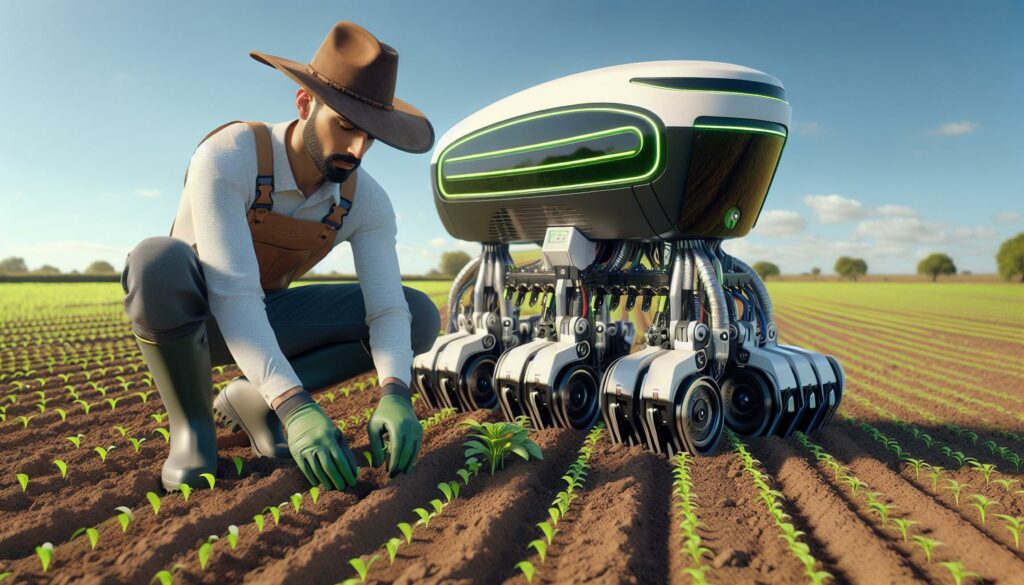Robotics is evolving at an incredible pace, and one of the most exciting areas is greenfield robotics. This innovative field focuses on creating robotic systems from the ground up, allowing for limitless possibilities in design and application. I’m fascinated by how these robots can be tailored to meet specific needs in various industries, from agriculture to construction.
As we dive deeper into greenfield robotics, we’ll explore the transformative potential these technologies hold. With advancements in artificial intelligence and machine learning, greenfield robotics is not just about building machines; it’s about reimagining how we interact with our environment. Join me as we uncover the trends and breakthroughs shaping this dynamic field.
- Definition and Scope: Greenfield robotics focuses on developing customized robotic systems from scratch, benefiting industries such as agriculture, construction, and environmental monitoring.
- Enhanced Efficiency: These tailored robots optimize processes, improving speed and accuracy in tasks like planting, harvesting, and material transportation.
- Cost Savings: Automation through greenfield robotics minimizes labor costs and enhances productivity, leading to significant long-term financial benefits.
- Sustainability Impact: Greenfield robotics promotes eco-friendly practices by reducing resource waste and minimizing environmental footprints, especially in agriculture and conservation.
- Technological and Regulatory Challenges: Adoption faces hurdles, including limited technology capabilities and complex regulatory frameworks that may delay innovation and implementation.
- Future Trends: The field is evolving towards intelligent automation, customization, human-robot collaboration, and sustainability efforts, supported by advancements in AI and machine learning.
Greenfield Robotics
Greenfield robotics involves developing robotic systems from the ground up, allowing for high levels of customization and adaptability. Industries, such as agriculture, construction, and manufacturing, benefit significantly from this approach.
In agriculture, greenfield robots can perform tasks like planting, harvesting, and weeding more efficiently than traditional methods. These robots adapt to specific crops, environment conditions, and planting practices. Customization enhances productivity and minimizes resource use.
In construction, greenfield robotics revolutionizes job sites by automating labor-intensive tasks. Robots can handle material transportation, masonry, and even monitoring safety conditions. By designing robots for specific projects, companies increase efficiency and reduce costs.
The integration of artificial intelligence and machine learning in greenfield robotics drives advancements in autonomy and decision-making. Robots can learn from their environments, optimizing operations based on real-time data. This evolution opens the door for new applications across various sectors.
As the field of greenfield robotics progresses, the potential for development becomes vast. Various industries will likely continue embracing tailored robotic solutions, improving efficiency, safety, and sustainability in their operations.
Applications of Greenfield Robotics
Greenfield robotics finds applications across various industries, showcasing its versatility and impact. The development of these robotic systems addresses specific needs within agriculture, construction, and environmental monitoring.
Agriculture
Agriculture benefits significantly from greenfield robotics through enhanced crop management. Robots designed for planting optimize seed placement based on soil conditions, improving yields. Harvesting robots assess crop ripeness, enabling timely collection and reducing waste. Weeding robots use computer vision to identify and remove unwanted plants, minimizing herbicide use. These systems adapt to diverse crop types, providing tailored solutions that increase efficiency and sustainability in farming practices.
Construction
Construction sites leverage greenfield robotics for improved operational efficiency. Robotic systems automate tasks like bricklaying, welding, and material transport, significantly reducing human labor costs. Safety monitoring robots navigate job sites to detect hazards in real-time, increasing workplace safety and compliance. Custom-designed construction robots respond to the dynamic nature of building environments, enabling faster project completion while maintaining high-quality standards.
Environment Monitoring
Environmental monitoring sees advancements with the deployment of greenfield robotics. Drones and ground robots equipped with sensors collect data on air and water quality, monitoring ecosystems efficiently. These systems analyze environmental changes, providing critical information for conservation efforts. By deploying tailored robotic solutions, I can support significant advancements in environmental stewardship and sustainability initiatives.
Benefits of Greenfield Robotics
Greenfield robotics offers a range of advantages across various industries, significantly impacting efficiency, costs, and sustainability. Each benefit contributes to making greenfield robotics an essential aspect of modern automation.
Increased Efficiency
Increased efficiency is a primary benefit of greenfield robotics. Custom-designed robots cater to specific tasks, enhancing speed and precision. For example, in agriculture, planting robots optimize seed placement by assessing soil conditions, ensuring optimal crop growth. Harvesting robots analyze crop ripeness in real time, enabling timely collection and reducing waste. These specialized robots adapt seamlessly to varied environments, ensuring operations run smoothly and effectively.
Cost-Effectiveness
Cost-effectiveness arises from the ability of greenfield robotics to minimize labor and material expenses. Automation reduces the need for human labor in high-risk tasks, such as construction welding or bricklaying, which lowers injury-related costs. Also, robots operate continuously, maximizing productivity without downtime. For instance, the deployment of robots for material transport can cut expenses related to logistics, freeing up resources for other project areas. The initial investment in robotic systems pays off through long-term savings and increased output.
Sustainability
Sustainability is another crucial advantage of greenfield robotics. Environmental monitoring robots provide actionable data on air and water quality, informing conservation efforts. These robots can apply only the necessary resources, such as water or fertilizers, reducing waste and minimizing negative environmental impacts. In agriculture, weeding robots significantly decrease herbicide usage by identifying and removing weeds without chemicals. Using robots minimizes the ecological footprint while promoting sustainable practices across industries.
Challenges Facing Greenfield Robotics
Greenfield robotics presents various challenges that can impact its growth and implementation. Key obstacles include technological barriers and regulatory issues that need addressing for successful integration into industries.
Technological Barriers
Technological barriers hinder the rapid adoption of greenfield robotics. Limited processing power and battery life restrict the capabilities of autonomous systems. For example, many robots struggle with complex navigation in dynamic environments, affecting their efficiency. Additionally, high costs associated with research and development deter investment in innovative robotic solutions. Integration of artificial intelligence and machine learning into robotic systems poses further challenges, primarily related to data security and algorithm reliability. Organizations often require advanced training programs for personnel to effectively operate and maintain these innovative systems, adding to the initial investment.
Regulatory Issues
Regulatory issues create significant obstacles for greenfield robotics. Compliance with safety regulations can be complex, as existing frameworks may not adequately address the unique characteristics of robotic systems. For instance, agricultural and construction robots must meet specific safety standards to operate alongside human workers. Certification processes for new technologies can be lengthy, delaying market entry and adoption. Additionally, variations in regulations across regions complicate the standardization of robotic systems, leading to increased costs and operational challenges for businesses looking to expand their market reach. Balancing regulatory compliance with the need for innovation remains a crucial hurdle in the advancement of greenfield robotics.
Future Trends in Greenfield Robotics
Emerging trends in greenfield robotics indicate a significant shift towards greater integration of advanced technologies, thereby enhancing capabilities and performance across various sectors. Innovations in artificial intelligence and machine learning are pivotal, enabling robots to learn from environmental data, adapt to changing conditions, and make real-time decisions. Increased data availability fosters intelligent automation, facilitating predictive analytics for optimized operations.
Customization remains a focal point in greenfield robotics, with a growing emphasis on designing robots tailored to specific tasks. These targeted solutions address unique challenges within industries, enhancing efficiency and productivity. For example, in agriculture, robots specifically engineered for diverse crop types can significantly boost yield and resource management.
Collaborative robotics is gaining momentum as well. Human-robot collaboration (HRC) setups enhance workflow by allowing robots to assist human workers directly. This trend supports safer work environments, particularly in construction, where robots can handle hazardous tasks while humans focus on oversight and critical decision-making.
Sustainability plays a vital role in future developments. Greenfield robotics aims to minimize environmental impact, reducing energy consumption and waste. Innovations like energy-efficient robots and biodegradable materials in manufacturing processes align with global sustainability goals. These efforts position businesses as responsible entities committed to reducing their carbon footprints.
Regulatory advancements will shape the future of greenfield robotics as well. Efforts to standardize regulations across regions will streamline compliance processes, fostering innovation and encouraging investment. Simplified certification protocols for robotic systems will accelerate market entry and enhance operational capabilities for businesses.
Investment in scalable robotics solutions is a key trend in greenfield robotics. More organizations are recognizing the long-term benefits of integrating adaptable robotic systems. As technology advances, scalable implementation will enhance operational efficiency and resource allocation across sectors.
Telepresence and remote operation capabilities will redefine how robots are deployed. These features enable operators to control robots in real-time, facilitating remote monitoring and interventions in hazardous environments. Utilizing robust communication networks, companies can enhance operational safety and efficiency.
The continuous evolution of greenfield robotics signifies a transformative shift in how industries operate. Alongside advancements in technology and sustainability, ongoing research and development efforts will drive innovation, positioning robots at the forefront of operational excellence.
The journey of greenfield robotics is just beginning and it’s exciting to witness how these innovations are reshaping industries. Custom-designed robots are not only enhancing efficiency but also paving the way for sustainable practices.
As I explore the future of this field I see immense potential in integrating advanced technologies like AI and machine learning. These advancements will enable robots to adapt and learn in real-time which is crucial for tackling unique industry challenges.
The ongoing evolution in greenfield robotics promises to revolutionize how we approach tasks across agriculture construction and environmental monitoring. With continuous investment and innovation the possibilities are endless and I can’t wait to see what lies ahead.

